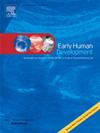Neurodevelopment in the transition to school in children subjected to hypothermia due to neonatal hypoxic-ischemic encephalopathy: A prospective study
IF 2
3区 医学
Q2 OBSTETRICS & GYNECOLOGY
引用次数: 0
Abstract
Introduction
Despite therapeutic hypothermia (TH), children with neonatal hypoxic-ischemic encephalopathy (HIE) still have a high risk of developing long-term neurodevelopmental disabilities. Magnetic resonance imaging (MRI) is a good predictor of severe injury, but neurodevelopmental prognosis in milder forms is challenging.
Aims
To characterize and compare the neurodevelopmental trajectory of children with HIE who underwent TH during the transition to school and determine the prognostic value of neonatal brain MRI.
Methods
Newborns undergoing TH were subjected to prospective neurodevelopmental and clinical follow-ups. MRI images were classified according to Weeke's score. Neurodevelopmental outcomes at 18–36 and 48–78 months of age were graded as: moderate-severe, mild, or no disabilities. Weeke's total score and gray matter (GM) and white matter (WM) subscores' predictive value were calculated at 48–78 months.
Results
Fifty-eight infants were included. Eight died (13.8 %). At 18–36 months, 72.0 % had no disability, 8.0 % mild, and 20.0 % moderate-severe. At 48–78 months, 43.6 % had no disability, 23.0 % mild, and 33.3 % moderate-severe. Comparing both time points, cognitive performance declined in 11 children (28.0 %; p = 0.002). Fifty-six percent developed neurodevelopmental sequelae. The MRI total score, GM, and WM subscores were good predictors of disability, particularly moderate-severe or death. Children with mild disability had higher MRI WM subscores than GM subscores and higher WM subscores than those with no disability.
Conclusions
Long-term follow-up is essential, even for children with normative early neurodevelopment. Neonatal MRI has strong prognostic value in distinguishing disability from no disability but is less effective in mild impairment prediction.
新生儿缺氧缺血性脑病导致的低体温儿童过渡到学校的神经发育:一项前瞻性研究
尽管治疗性低温(TH),新生儿缺氧缺血性脑病(HIE)的儿童仍然有发展为长期神经发育障碍的高风险。磁共振成像(MRI)是一个很好的预测严重损伤,但神经发育的预后较轻的形式是具有挑战性的。目的描述和比较接受TH治疗的HIE患儿在转学期间的神经发育轨迹,并确定新生儿脑MRI的预后价值。方法对行TH手术的新生儿进行前瞻性神经发育和临床随访。根据weekk的评分对MRI图像进行分类。18-36个月和48-78个月时的神经发育结果分为:中度-重度、轻度或无残疾。在48 ~ 78个月时计算周总评分及灰质(GM)和白质(WM)评分的预测值。结果共纳入58例婴儿。死亡8人(13.8%)。在18-36个月时,72.0%无残疾,8.0%为轻度残疾,20.0%为中重度残疾。在48-78个月时,43.6%的患者无残疾,23.0%为轻度残疾,33.3%为中重度残疾。比较两个时间点,11名儿童的认知能力下降(28.0%;p = 0.002)。56%的人出现了神经发育后遗症。MRI总分、GM和WM亚评分是残疾,特别是中重度或死亡的良好预测指标。轻度残疾儿童MRI WM评分高于GM评分,WM评分高于无残疾儿童。结论长期随访是必要的,即使对早期神经发育正常的儿童也是如此。新生儿MRI在区分残疾和无残疾方面具有很强的预后价值,但在轻度损伤预测方面效果较差。
本文章由计算机程序翻译,如有差异,请以英文原文为准。
求助全文
约1分钟内获得全文
求助全文
来源期刊

Early human development
医学-妇产科学
CiteScore
4.40
自引率
4.00%
发文量
100
审稿时长
46 days
期刊介绍:
Established as an authoritative, highly cited voice on early human development, Early Human Development provides a unique opportunity for researchers and clinicians to bridge the communication gap between disciplines. Creating a forum for the productive exchange of ideas concerning early human growth and development, the journal publishes original research and clinical papers with particular emphasis on the continuum between fetal life and the perinatal period; aspects of postnatal growth influenced by early events; and the safeguarding of the quality of human survival.
The first comprehensive and interdisciplinary journal in this area of growing importance, Early Human Development offers pertinent contributions to the following subject areas:
Fetology; perinatology; pediatrics; growth and development; obstetrics; reproduction and fertility; epidemiology; behavioural sciences; nutrition and metabolism; teratology; neurology; brain biology; developmental psychology and screening.
 求助内容:
求助内容: 应助结果提醒方式:
应助结果提醒方式:


